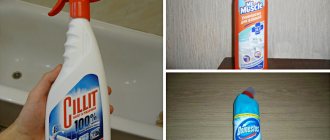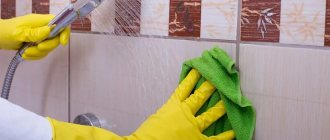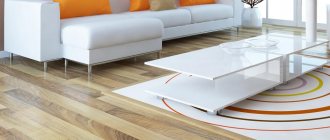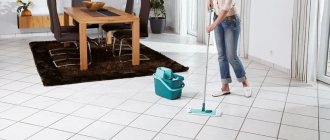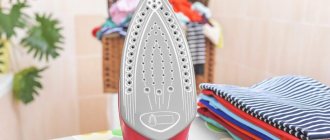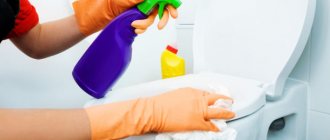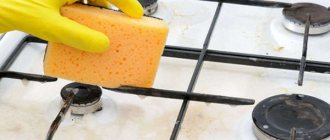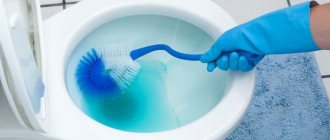One of the most durable wall and floor coverings is ceramic tiles. The use of modern technologies allows us to produce tiles from a wide variety of materials. Starting from marble and granite, and ending with artificial compounds that can compete with natural materials in strength and durability.
It is worth paying tribute to the designers. The variety of shapes, sizes and colors allows you to turn your bathroom into a real work of art. Many people do not refuse to use tiles in the kitchen. The floor and work area, finished with ceramics, are easily cleaned of dirt and retain an attractive appearance for a long time. We will talk about cleaning ceramic tiles.
Among the wide range of cleaning products that differ in composition and methods of action, it is easy to get confused. It is worthwhile to thoroughly understand how to choose the best tile cleaning product and not make a mistake.
No. 1. Special tile cleaning products
The industry has long developed a lot of special compounds that help wash away plaque, greasy stains, various types of dirt and even traces of mold from tiles. Under the trademarks “Silit”, “Santik”, “Domestos”, “Komet”, “Sif”, “Mr. Muscle” and others, products are produced that in a matter of minutes allow you to return the tiles to their original appearance.
Before purchasing, it is important to read very carefully the instructions for use and the type of tile that can be cleaned with such products. It is better to take cream or gel-like compositions - products with abrasive particles can leave a lot of small scratches , in which dirt will accumulate in the future. It is also worth considering the chemical resistance class of the tile: tiles of class A and AA are the most resistant to various types of aggressive agents and will easily survive almost any impact, which cannot be said about tiles with resistance rating C.
It is advisable to take a product that contain chalk . If the seams between the tiles are treated with epoxy grout , then acid-containing are also prohibited . a whitish coating appears on the tiles, it is better to use a product containing chlorine . The processing method will be indicated in detail on the packaging - it must be followed carefully.
What does the type of cladding affect?
For tiling surfaces in the bathroom, tiles with different characteristics can be selected. All its features must be taken into account during the cleaning process .
Matte coating
On a matte surface, traces of water and soap splashes appear after drying in the form of a whitish coating. Due to the specific nature of the tiles, it is advisable to use solutions with good penetrating ability. For example, vinegar solution for wall tiles and soda solution for floor coverings.
After cleaning, the matte wall covering can be rubbed with glycerin. It is not recommended to do this with floor tiles as they will become slippery.
Embossed
It is more difficult to keep textured tiles clean than matte and glossy ones. An uneven surface with depressions and protrusions allows dirt to accumulate on such a coating.
To deal with dark stains in recesses, you will need a brush and cleaning products that provide good penetration .
Gloss
Glossy tiles should not be washed with abrasive products. The best choice is liquid and gel non-aggressive preparations, which are applied and distributed with a sponge or rag.
Mirror and glass cleaner is also . This approach will give the tiles a streak-free shine.
To maintain the cleanliness and shine of a smooth surface, a moisture-repellent agent can be applied on top of it.
Floor tiles
Cleaning floor tiles is carried out similarly to wall tiles. The same store-bought products and homemade formulations will do .
The regularity of floor cleaning depends on the intensity of use; it should be carried out regularly. Most often, tiles with a matte surface are chosen as flooring.
No. 2. Dishwashing liquid or soap
Light stains can be washed with ordinary dishwashing detergent . It is enough to dissolve a small amount of it in warm water until foam forms. The resulting solution is applied with a sponge to the contaminated tiles, left for 10-20 minutes , and then thoroughly washed off with plain water.
Instead of detergent, you can use regular toilet soap ( using laundry soap is not recommended ). To make the dissolution process faster, you can rub the bar soap into warm water. Next, the washing process is similar to that when using dishwashing detergent.
The most effective and efficient means
Some liquids and compositions from medicine cabinets and utility cabinets turn out to be the best removers of mold and old stains from tile surfaces. But due to their special chemical aggression, it is not recommended to use them often and regularly.
Use only in special cases. These include:
- Ammonia;
- Hydrogen peroxide solution;
- Chlorine powder.
The components of these products actively react with stains deeply penetrated into the ceramics, soften them and allow them to be removed with water. Overuse of chemicals will harm the tiles and worsen their physical characteristics and appearance.
No. 3. Glass cleaner
If a special means for washing tiles is not always at hand, then every housewife probably has a composition for washing glass and mirrors Almost every such product contains ammonia , which will help remove minor dirt from the tiles and restore it to its former shine. The cleaning method is no different from washing windows : you need to spray the composition, and then carefully treat the surface with a soft rag.
Useful tips and prevention
Tiling is very durable, but in order for it to maintain its attractive appearance and perform its functions, the surface must be properly cared for:
- The seams between the tiles can be treated with moisture-proof impregnation, which significantly extends the service life of the grout and prevents dirt from penetrating inside.
Protective impregnation Atlas Delfin for tiles and joints. - Before applying polish, clean the tiles thoroughly, trying not to leave streaks: any dirt will be visible under the protective coating. They can be removed only after removing the polish layer using special means.
- During repair work, try to prevent glue or working solution from getting on the cladding, and if this does happen, immediately wipe off the dirt with a wet rag.
- With increased hardness of tap water, it is not advisable to leave the tiles wet for a long time: drops that dry on their own leave marks. At night, it is better to wipe the lining with moisture-absorbing cellulose or microfiber cloths.
- Constant dampness in the bathroom contributes to the appearance of mold, especially at the seams between the tiles. Therefore, good air exchange and ventilation are of fundamental importance.
- It is advisable to clean the tiles once a week, and the seams once every two weeks. Regular washing of tiles is the only way to avoid persistent plaque and ingrained dirt.
Advice! If you need bathroom renovation specialists, there is a very convenient service for selecting specialists from PROFI.RU. Just fill out the order details, the experts will respond and you can choose who to collaborate with. Each specialist in the system has a rating, reviews and examples of work, which will help with the choice. Looks like a mini tender. Placing an application is FREE and does not oblige you to anything. Works in almost all cities of Russia.
If you are a master, follow this link, register in the system and be able to accept orders.
No. 4. Lemon acid
Modern detergents are, of course, effective, but they also have disadvantages .
- Firstly, household chemicals can cause allergies .
- Secondly, it requires very careful handling, since sometimes the concentrations of aggressive chemicals in them can damage the skin of the hands and even the respiratory tract.
- Thirdly, some products cannot be washed off even with a large amount of water.
Therefore, it is not surprising that today many people abandon store-bought products and switch to using folk remedies.
The most popular and easiest way to clean ceramic tiles from grease , lime deposits and plaque is to use lemon juice . Problem areas should be thoroughly rubbed with lemon and left for a few minutes . Lemon juice can be squeezed out, diluted a little with water and sprayed with a spray bottle . After a few minutes, the juice is washed off with water . The bonus of this method is that the room will be filled with a pleasant and, most importantly, natural aroma.
An alternative is citric acid powder . The bag is dissolved in a glass of warm water and the resulting liquid is used for processing.
Why should you care about the cleanliness of your seams?
The most difficult type of dirt is dirt localized in the seams between the tiles. It's not easy to remove it from there. But it is necessary, since clean seams are not only a concern for the external beauty of the floor. The fact is that grout joints are a favorable place for the development of bacteria, mold, and mildew, which have a negative impact on human health. There are especially many of them in rooms where air humidity is quite high, as well as where floors are constantly exposed to moisture - near bathtubs, sinks, showers, pipes, etc.
Fungal plaque on the seams between tiles in the bathroom
Attention! Established dirt, as well as developed mold and mildew, are much more difficult to remove than just incipient ones.
Methods for removing contaminants
There are several basic methods for cleaning tile grout. They differ in complexity, means used and efficiency. Also, the choice of the most suitable method will depend on the intensity of the contamination.
Table. Methods for cleaning seams.
| Way | Characteristic |
| Chemical | Based on the use of various chemicals used in everyday life. These can be almost any products sold in stores - both those aimed at cleaning ceramics and ordinary ones. Products containing chlorine and bleach work best to remove dirt in bathrooms, mold, and mildew. In the kitchen, it is better to use alkaline compounds. Oxygen bleaches, which are used in a diluted state of 1:2, have performed well. They are left applied to the contaminated areas for 30 minutes, after which the treated area is brushed and washed with clean water. |
| Mechanical | A radical cleaning method, which is used if the chemical cleaning method has no effect. In this case, the seams are processed with fine-grained sandpaper, a coarse brush, and a special knife. The main thing is to remove the contaminated layer. You can also completely replace the old grout by removing it with a new one. |
| People's | The method is to use improvised means that are in the house. This can be soda, vinegar, citric acid and much more. All methods are based on folk recipes, which can be found below. |
| Steam cleaning | A steam cleaner is a good way to remove dirt. Here, dirt is removed under high temperature, pressure and steam. The method is effective in fighting fungus. The method is effective, after which the remaining dirt can be easily removed with a soft cloth. |
Attention! It is important to first test the effect of any chemical on an inconspicuous area of the floor, only then can it be used on the rest of the surface if there is no negative reaction.
Cleaning the joints between tiles
It may not be possible to choose the best method right away, so you need to try different ones, starting with the simplest and most gentle.
What will you need?
Let's look at what can be useful for cleaning seams. Here is a general list of tools and tools, but, depending on the chosen method, some items may not even be needed:
- an old toothbrush or small brush;
- knife;
- spatula and grout;
- rags;
- fine-grained sandpaper;
- sponge;
- scraper;
- gloves;
- bucket with water.
We prepare everything you need
Household chemicals, washing powder, soda, vinegar, hydrogen peroxide, lemon, and salt can be used as cleaning products. For the final stage of cleaning, preventative agents may also be useful, the action of which is aimed at protecting cleaned or fresh grout.
How to clean the seams between tiles?
Traditional methods are the most popular methods of cleaning tile joints. This is because to bring them to life, natural ingredients prepared with your own hands are used. You don’t have to spend extra money on purchasing specialized medications. By the way, traditional methods sometimes turn out to be more effective than household chemicals, but everything is individual - sometimes they may not help.
One of the most popular methods is cleaning seams with lemon juice . This option is suitable for light grout. The juice does an excellent job of removing rust, plaque, and various other types of dirt, but not old stains. It's easy to use - just apply it to the stained seam and leave for 15 minutes, then wash it off along with the dirt.
Lemon, vinegar and soda
Another effective method is to use a product made with vinegar and soda . In this case, vinegar and water (100 ml each) are mixed 1:1 in a container, and a package of baking soda is dissolved in them. The mixture copes well with various types of contaminants, defeating even old ones. Neither rust, nor grease, nor dry dirt can resist its action. Even mold and bacteria are powerless and will easily leave the seams that are comfortable for them. The most important thing is to make sure that the mixture does not change the color of the grout before use. The drug is applied to the seams for 15 minutes, after which the contaminated area is cleaned with a brush. Then just rinse with water.
Cleaning tile joints
Attention! To clean seams, it is recommended to use soft or medium-hard brushes.
Baking powder can also be used to clean seams . It is an excellent fighter against fat, deposits, and stubborn stains. Apply to moistened seams and rub over them, and after 30 minutes wash off with water.
Baking powder (baking powder)
You can also try to remove stains with whitening toothpaste . The method is suitable for cleaning white seams. The paste is applied to an old toothbrush and rubbed into the seams, after which it is washed off with clean water.
Whitening toothpaste
After the seams are cleaned, it is recommended to treat them with protective agents, which will prolong the effect of cleanliness for a longer period. A special solution is applied to the grout using a thin brush, but it cannot be applied to the tiles. After this composition dries, the seams will be washed quickly and easily, and less dirt will be retained in them. In this case, the grout can retain its original appearance for 10 years or more.
The seams are treated with a protective compound
Cleaning seams after repair
The process of cleaning the seams and the tiles themselves after the repairs deserves special attention. After such work, particles of paint, solutions, mixtures, glue and other repair compounds may appear on the floor. And a standard detergent, especially plain water, won’t do the job. To clean the seams from dirt after repair, kerosene, ammonia or various solvents are used. All these products cannot be used in concentrated form, only diluted. They have a softening effect on stains, after which the stains come off easily.
Washing the bathroom floor
If none of the above remedies help, then you can remove the dirt using a scraper. If a stain is removed from the surface of a tile, then you need to act carefully without damaging the surface.
If a fungus has developed
The fungus is quite difficult to remove; sometimes the best method of combating it is to completely replace the grout or even the tile covering. The old grout is removed with a scraper, the seams are cleaned of its residues, dried and filled with fresh grout. It is important that the floor is dry before using it.
Grouting tiles in the bathroom
No. 6. Soda
Soda itself can also have a good effect on fatty stains . In general, this substance is considered a universal cleaning agent; it can also be used to remove, for example, coffee and tea stains that have become ingrained in dishes.
The washing method is the simplest: wet a sponge, dip it in soda powder and begin to carefully work the surface of the tile, dipping the sponge in soda powder again and again as necessary. Plaque and dirt should be cleaned thoroughly, but you should not press too hard to avoid scratching the tile. The method is effective even with serious contamination .
How to clean seams
While the tile itself is fairly easy to clean, dirt gradually accumulates in the seams. They absorb liquid and can darken or become a breeding ground for mold. To clean seams, you need to use other means: acids and aggressive powders can damage them. There are several effective and safe methods.
- Small stains can be cleaned with a regular eraser.
- Make a paste of baking soda and water, diluted in equal parts. Apply to the seam and scrub with a soft brush.
- For light-colored seams, you can use bleach. It needs to be diluted with water 3:1 and applied to the seam, and then cleaned with a brush.
- Mix equal parts hydrogen peroxide, baking soda and dishwashing liquid. Apply to seams and wash off after 2 hours.
- To remove mold, you need to dilute a glass of borax in 3 liters of water. Apply to seams and rub. Do not rinse, just wipe with a dry cloth.
- Dilute 100 ml of vinegar with the same amount of water, add 500 g of soda. Apply to the seams and after 15 minutes brush over them.
The first place in caring for a tile floor is a broom and spatula. The use of a broom has been known for centuries and, although the material from which it was made has changed, the principle of its operation is the same. Use a broom for surface cleaning - collecting dust and debris. Then, by applying one or more of the products listed below, achieve a perfectly clean floor.
Some stains cannot be removed with a broom and spatula. This is, in particular, a spilled liquid typical of a kitchen floor. In this case, use a bucket and a mop to wash the floor. Mops are usually made with cotton or sponge pads. A cotton mop is more suitable for removing old stains. The porous surface of a sponge mop will be useful especially when you need to remove spilled liquid.
How to wash dirty tiles without streaks:
- It's best to do the worst job first - cleaning the seams and corner joints, then mopping the floor. To clean the grouts, apply detergent to them and leave for a few minutes. We clean the joints with a brush (for example, a toothbrush), remove the remaining cleaning substances with a cloth and, finally, wash the entire surface of the floor.
- To clean tiles, use a mild all-purpose cleaner diluted in water. Apply the solution to a small area of the floor and leave for a few minutes. While one area is soaking, work on another. Then return to the first cleaned surface and wipe it with a clean cloth. The floor will shine like new.
- To keep your tiles clean and shiny, remember to re-clean them as needed (in the kitchen, several times a week). Cleaning once a month is not enough. Buy a suitable mop for wiping the floor. Keep it handy. Try to wash every stain that appears.
Sometimes you have to scrub the tiles on the floor not only from dirt and limescale. A relatively common problem is mold in corners and seams.
How to clean fungus on tiles:
- Sweep the floor with a broom, collect dust and large particles of dirt.
- Mix:
- ½ tbsp. soda;
- ⅓ tbsp. ammonia;
- ¼ tbsp. vinegar;
- 7 tbsp. warm water.
- Pour the solution into a spray bottle.
- Spray the mixture onto the part of the floor with joints affected by fungus and immediately absorb the liquid with a cloth or a washing vacuum cleaner. Do not allow water to get into the joints. Continue until you have cleaned the entire floor. If necessary, this mixture can be used again to eliminate fungus.
- Use a cloth or paper towel to remove any remaining water from the cleaned seams.
How to clean fat
To clean the tiles on the floor from stubborn dirt and grease, use vinegar and soda. This mixture will dissolve dried dirt and soften fatty deposits typical of the kitchen. Using both ingredients, create a paste which you apply to the tile and leave for a few minutes. Wipe with a damp cloth.
Vinegar and soda are suitable for cleaning textured (rough) tiles, regardless of color. This mixture will refresh the light surface and restore the brightness of the colorful tiles.
You can also use lemon. This is an excellent cleaning assistant that easily washes away stubborn stains (from soups, sauces, and other products that stick to the tiles). Wipe the dirt with a sliced lemon or juice. Dirt, even if it is deeply ingrained, will dissolve.
No. 7. Vinegar
Acetic acid , like citric acid, can destroy fatty deposits, plaque and other contaminants. It is better to use regular table vinegar with an acetic acid concentration of no more than 6%. If you only have vinegar essence with a concentration of 80% , then it is better to dilute it with water in a ratio of 1:11.
to apply the vinegar solution to the tiles using a spray bottle . If there is serious dirt on the surface, it is better to leave the product for 20-30 minutes so that it breaks down the plaque. The surface with vinegar applied to it can be additionally cleaned a soft brush of a neutral color. After the manipulations, all that remains is to rinse the surface with warm water and wipe it with a soft microfiber cloth.
A big advantage of the method is the harmful effect of vinegar on mold , but when working with acid it will be necessary to protect your hands and respiratory organs . This method is not suitable for those who are hypersensitive to odors. Frequently washing tiles with vinegar can lead to destruction the joints between the tiles , so it is better to alternate this method with others.
Cleaning tiles - instructions
Let's look at how the process of cleaning floor tiles is carried out.
Step 1. First of all, use a vacuum cleaner or broom to collect all large particles of debris. It is recommended to dry clean the coating daily.
Removing large debris with a vacuum cleaner
The floor is being swept
Step 2. Next, clean the floor with a damp cloth. This will help collect any remaining dust. Corners and hard-to-reach places are thoroughly washed.
Wet floor cleaning
Step 3. The floor is thoroughly washed with a mop soaked in water. If the base is relatively clean and does not have heavy contamination, then it is not necessary to use cleaning agents if daily cleaning is carried out.
The floor is washed with a mop
Step 4. Wipe the floor dry with a soft cloth.
The floor is wiped dry
Step 5. If something was spilled on the floor, it is important to quickly wipe the stain dry. This will prevent contaminants from being absorbed into the seams.
If something has been spilled on the floor, it is important to quickly wipe the stain dry
Step 6. Heavy areas of contamination are treated with special cleaning agents if necessary.
Cleaning agents are used for severe stains
Step 7. If it is necessary to remove stubborn stains from the tiles, then prepare a cleaning agent - mix water and washing powder in a 1:1 ratio. The result is a cleaning paste.
Washing powder mixed with water
Step 8. Using a rag, apply it with rubbing movements onto the contaminated surface and leave it there for 5-10 minutes.
The rag is blotted with cleaning paste.
Step 9. The surface is treated with a soft brush and washed with water to remove any remaining paste. The method can be repeated several times depending on the intensity of contamination.
The surface is treated with a soft brush
Step 10. If mold appears on the floor, then fight it as follows: a solution is prepared using ammonia and water in a 1:1 ratio.
Ammonia mixed with water
Step 11. The product is applied to the mold with a brush and processed by rubbing the surface.
The desired area is rubbed with a brush
Step 12. After removing the mold, the surface of the tile is wiped with clean water and wiped dry.
Finishing cleaning the tiled floor
No. 9. Hydrogen peroxide solution
This remedy is called universal and very effective. It will help cope with any kind of pollution , and all components can be found in almost any home. The paste is prepared from ½ cup of baking soda, ¼ cup of hydrogen peroxide and 1 tsp. liquid soap . All components are thoroughly mixed. If the contamination is minor, the paste can be applied to a sponge and wipe the desired area, then rinse the surface with water. If the contamination is severe, then the paste can be left for 10 minutes : the dirt will begin to dissolve under the influence of the components of the mixture and in the end it will be much easier to wash off.
How to clean the seams between tiles
Tile seams are very vulnerable areas on the cladding. Their porous surface allows moisture to pass through well and quickly becomes dirty. It is in the seams that mold often settles and a yellow coating appears. The poor resistance of the grout to potent substances further complicates its maintenance.
You can clean the seams between the tiles with an old toothbrush using the safe folk methods listed above.
To treat seams, you can prepare a homemade bleaching paste based on hydrogen peroxide. To do this, combine ¼ cup of peroxide, ½ cup of soda and 1 tbsp. l. liquid soap. The mixture can be stored in a closed glass or plastic container.
To combat mold, chlorine-based products are used (Belizna, Domestos).
It is possible to use household chemicals, but frequent use of acidic compounds helps to gradually wash out the grout mixture from the joints.
A steam cleaner gives a good result: hot steam penetrates deep into the pores and effectively cleans the seams even without the use of detergents.
Note: It is not advisable to frequently wash tile joints with dishwashing detergents or washing gels (with the exception of antibacterial compounds). The remaining product gets clogged into the pores of the grout and, combined with high humidity, creates a breeding ground for mold.
We recommend: 9 ways to clean tile grout.
No. 10. Chlorine powder (white)
Bleach can cope with the most serious contaminants , it is an effective disinfectant that allows you to simultaneously solve the problem of mold and mildew , so this method is often used in damp rooms. Chlorine powder is diluted in water , the solution is poured into a spray bottle and sprayed onto the contaminated surface for 10-15 minutes , then wipe the tiles with a sponge to remove dirt, and then with a well-dampened rag.
When working with such an aggressive product, you need to wear gloves , or even better, use a mask to protect your respiratory system . It is not recommended to use bleach frequently , otherwise you can not only dissolve plaque, but also damage the surface of the tile and discolor the grout . Some housewives use ready-made liquid such as “Belizny” .
Rating of the best products for tiles
| Nomination | place | Name of product | price |
| Rating of the best products for tiles | 1 | Mellerud 1 l | 469 ₽ |
| 2 | HG 1000 ml | 390 ₽ | |
| 3 | VIclean proTECt, 1 l | 340 ₽ | |
| 4 | Emsal | 350 ₽ | |
| 5 | Pip, 500 ml | 510 ₽ | |
| 6 | Prosept Multipower, 1 l | 220 ₽ |
Mellerud for tiles and stones, 1 l
Rating: 4.9
German highly effective cleaning agent for tiles and natural stone tiles. Copes with any type of contaminant, literally corroding them in a matter of minutes. One liter bottle is enough for 12-15 square meters of washing in its pure form. But you can dilute the product in a ratio of 1:5, and then it will be enough for 40-50 square meters. It turns out to be quite economical, considering the price of 469 rubles.
Made with phosphoric acid, it creates an acidic reaction. Therefore, it cannot be used on surfaces that contain lime in any form - for example, Mellerud is not suitable for cleaning granite or marble. Otherwise, the tile may lose its appearance and collapse.
Advantages
- Removes all contaminants, including stubborn ones.
- Suitable for natural and artificial tiles.
- It's inexpensive.
Flaws
- May damage tiles.
HG for cleaning glossy tiles without streaks, 1000 ml
Rating: 4.8
HG for cleaning tiles comes from the Netherlands. Created specifically for glossy surfaces. After cleaning, there will be no annoying streaks left on the smooth tiles. One bottle is enough for at least 10 five-liter buckets. That is, with one bottle you can wash the floor 10 times if it is very dirty. Or 20 times if the tile is slightly dirty.
The product is acidic. Therefore, it is not suitable for natural stone containing lime. For one cleaning you need to add 50 milliliters of product to 5 liters of warm water. If the floor is very dirty, then 100 milliliters. Before use, it requires removing all other chemical compounds from the floor using a special product from the same company. Otherwise, streaks will appear.
Advantages
- Very economical consumption.
- Perfectly clean glossy tile surface.
Flaws
- May damage natural stone.
No. 11. Steam cleaner
If your apartment has a steam cleaner, it can also be used to clean ceramic tiles. Hot steam , escaping under high pressure, is capable of heating and dissolving contaminants . In this way, you can remove grease stains, plaque, deal with mold, neutralize spores and germs. After treatment, the surface of the tile must be cleaned with a damp sponge and then wiped dry with a soft cloth.
Use of improvised means
From what is always in the house, inexpensive and effectively fights plaque, dirt, stains:
- Laundry soap. It is advisable to use the lump version. Liquid laundry soap is not so effective, even if it is from the expensive series.
- Soda.
- Toothpaste.
- Hydrogen peroxide.
- Ammonia.
- Boric alcohol.
- Lemon acid.
- White.
When cleaning tiles, you can use dishwashing gel or liquid soap. Experienced housewives advise wiping the tiles in the bathroom, including the floor, every time after water procedures.
Just a soft sponge or flannel cloth will be enough. But almost none of the ordinary housewives will find the time and patience to clean so often.
No. 12. Melamine sponge
A melamine sponge allows you to do without special cleaning agents ; more precisely, it is a detergent. Such sponges are made from melamine foam, which is capable of penetrating any hard surface and removing all kinds of dirt , stains and deposits. To clean, you only need to wet the sponge with plain water, using minimal effort. The melamine sponge can be used to clean a wide range of surfaces, incl. tiles.
KIILTO CLEAN
A special acid concentrate suitable for washing glossy tiles. It will not spoil its shiny surface or scratch it. Thanks to this product, you can easily remove residual adhesive (if the tiles have just been glued), dried mortar and other complex contaminants. The product is economical to use, since it needs to be diluted due to its concentrated composition.
Pros:
- Economical concentrate;
- Removes dried glue and mortar, as well as other heavy contaminants.
Minuses:
- Requires more thorough rinsing;
- May leave whitish streaks;
- High price.
No. 13. Cleaning tile joints
Often the most problematic area is the tile seams. The most effective among all the cleaning agents listed above will be special gels sold in household appliance stores. , vinegar, a solution of ammonia or ethyl alcohol, and a steam cleaner work best
If the seams are so dirty that none of the methods can clean them, then you will have to take radical measures - completely change the grout:
- old grout cleaned up painting knife (they make several cuts, and a layer of old grout begins to fall out), with an electric chisel (an expensive tool) or a screwdriver with a brush attachment (use low speed);
- fungus and mold are carefully cleaned;
- treatment a special impregnation , which will kill remaining mold spores and prevent further development of the fungus;
- When the antiseptic is completely dry, you can proceed to applying a new layer of grout.
It is worth noting that if the tile is more than 15 years old , then it is necessary to remove the old grout very carefully , since it may be the last binder that allows the tile to stay on the surface of the wall or floor.
Why does pollution occur?
The answer to this question is quite simple - if the floors are not properly cared for, the tiles quickly get dirty and lose their appearance. Over time, it can become covered with such a layer of dirt that it even loses its color. Fortunately, those owners who keep their home clean are unlikely to encounter such problems. Although, for example, in the kitchen it is always more difficult to clean tiles - this is due to the specific nature of the substances that stain them. While it is easier to wash off ordinary dirt in the bathroom, it is not so easy to wipe off old grease stains.
On a note! To avoid having to resort to aggressive methods of dealing with tile contaminants in the kitchen, it is better to remove all substances that accidentally fall on it immediately using a damp cloth or sponge. Old stains are much more difficult to remove.
How to clean tile floors
Another problem that even caring owners face is contamination of the joints between individual floor elements . The base is constantly in contact with dirt, dust, various substances, it is wiped with a rag and it is considered that all work on cleaning the floor is completed. However, seams are generally more difficult to clean. This is due to the structure of the grout filling them. The fact is that it is a fairly porous and rough material, on which various contaminants easily linger. It won’t be difficult to clean the tile itself, but removing all the dirt from the seams is more difficult.
The main types of contamination of the tile itself and the seams between it are as follows:
- some types of detergents that are difficult to rinse off with water;
- dirt from the street;
- food;
- excess moisture;
- dust;
- fungus and mold;
- remnants of building materials used during apartment renovation.
Fungus between floor tiles
The grout may also darken on its own over time. Unfortunately, this process in fact cannot be completely prevented; it can only be slightly slowed down by taking preventive measures. You can also restore the seams between the elements to their former beauty by thoroughly cleaning them.
No. 14. Cleaning tiles after renovation
During repair work, specific compounds may come into contact with the tiles, and it is not always possible to cope with the universal means described above, so cleaning tiles after repairs should be a separate item.
- Cleaning from adhesive solution. The best option is to wash it while it is still wet. To do this you will need a damp cloth and rubber spatula. If the glue has already dried, it will be difficult to get by with water alone - you will have to do weak solution of ammonia or vinegar, and good wet traces of glue with it. Polymeric glue peel off acetone solution, but the main thing here is not to overdo it, so as not to damage the tile. When the glue is softened, it is cleaned off hard sponge, sandpaper or spatula, being extremely careful. The easiest way to remove glue residue is to use special solvents, but it is necessary to carefully analyze their composition for the presence of substances hazardous to tiles.
- Primer removal. It is also better to try to wash off traces of primer as soon as possible. If the solution hardens, you will have to resort to a special solvent-based remover, or use acetone.
- Cleaning grout . It is much easier to control the process of grout getting onto the tiles, so you can immediately remove the residue with a damp cloth. It will be more difficult to remove drops of epoxy grout from the tiles after it has dried - you cannot do without a special solvent.
- Cleaning silicone sealant . A thick layer of sealant residue can be removed mechanically by simply cutting off the unnecessary part with a knife. If we are talking about surfaces that are sensitive to mechanical stress (for example, an acrylic bathtub), then it is better to use a chemical cleaning method. For example, car wash is suitable.
How to choose the best option
Method of influence
On store shelves you can find powdered and liquid tile cleaning products. The first are abrasives that clean the contaminated surface through physical action. Solid particles create friction on the surface of the tile, removing dirt from it. Such products do an excellent job of the task and often clean even stubborn dirt.
But we must not forget about the downside of abrasive cleaning compounds: they can damage the tile surface, especially when it comes to glossy tiles. The powder breaks the top layer of the tile, leaving small scratches on its surface, often invisible to the eye: limescale accumulates in them, destroying the tile even deeper. The coating quickly loses its shine and presentable appearance.
A tile cleaner in the form of a liquid (gel, spray, paste, etc.) does not involve harsh physical, but chemical action. Removal of contamination occurs due to its reaction with the components of the cleaning product. If you choose the right option wisely, it will delicately and effectively clean the tiles of any dirt. Liquid formulations are considered the most popular and effective.
Compound
If the choice is made in favor of a non-abrasive product, it is important to determine the optimal one for yourself. There are acidic and alkaline options on the market. Products containing acid are ideal for removing inorganic contaminants (e.g. traces of rust or limescale). But you need to choose such compositions for tiles very carefully: if the tile contains limestone in its structure, an acidic product is not the best option. In addition, you should not use them for cleaning marble and granite stone.
Advice. Acidic compounds should be used with caution when caring for tiles whose seams are treated with calcium-containing grout and are not additionally protected.
Alkaline cleaners allow you to achieve more pronounced results than acidic ones. This option is optimal for removing soap and fat-based stains. The alkaline composition is considered universal: it is suitable for almost any tile. But here too you need to be careful. Sometimes manufacturers can add abrasive components (for example, soda) to the product, which have a detrimental effect on the glossy surface.
Coating features
It is the characteristics of the tiled covering that determine which product is best to purchase. Therefore, before purchasing a cleaning product, you need to study the composition of the tiles. If there is limestone among the components (or if it is a natural stone), you should immediately exclude all acidic cleaners from the possible options.
The room for which the cleaning product is intended also plays a role. Conventionally, household chemicals for tiles can be divided into options for bathrooms and kitchens. In the first case, the cleaner not only removes dirt from the coating, but also slightly illuminates its color.
